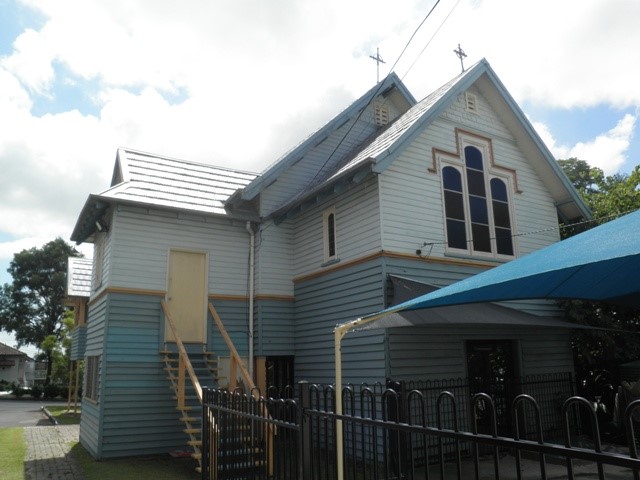Addresses
Type of place
Church, Hall
Period
Interwar 1919-1939
Style
Arts and Crafts
Addresses
Type of place
Church, Hall
Period
Interwar 1919-1939
Style
Arts and Crafts
The first St. Stephen’s Church of England on this site was constructed in 1922 to the design of H.W. Atkinson and was the first permanent Anglican church in the local area. In 1937 a parish hall was constructed to house the increasing numbers of children of the parish attending Sunday School. The congregation continued to thrive and develop with church services, Sunday School and social occasions held in these buildings. By the 1950s, the congregation had expanded to the extent that a larger church was required. In 1958, the current St Stephen’s Anglican church, designed by Horace George Driver, was contructed and the former church moved to the side of the lot to serve as a parish youth centre.
Also known as
St. Stephen's Church of England and Hall
Lot plan
Key dates
Local Heritage Place Since —
Date of Citation —
People/associations
Henry Wallace Atkinson - the former church (Architect)Criterion for listing
(A) Historical; (D) Representative; (G) Social; (H) Historical associationInteractive mapping
Also known as
St. Stephen's Church of England and Hall
Lot plan
Key dates
Local Heritage Place Since —
Date of Citation —
People/associations
Henry Wallace Atkinson - the former church (Architect)Criterion for listing
(A) Historical; (D) Representative; (G) Social; (H) Historical associationInteractive mapping
History
A meeting of Coorparoo residents in the Stephens Shire Hall on 4 May 1922 unanimously agreed to have a Church of England erected on the corner of Chatsworth and Cavendish Roads. The site had been purchased in 1921 by Reverend Saint Clare Donaldson, the first archbishop of Brisbane, for £574. The Building Committee, chaired by P. A. Blundell had over £354 of the £742 plus in promised donations on hand and called for tenders for the construction of the church which had been designed by honorary architect H. W. Atkinson. A “stump capping” ceremony was held in June where 70 or 80 stumps were simultaneously capped by parishioners who had had purchased them, raising another £65. The church was anticipated to be completed in 12 weeks and cost approximately £1400. Rev. A. E. Smith, of Goondiwindi was expected to take charge of the parish in the near future.
The completed church was dedicated and named after the martyr Saint Stephen on 8 October 1922. The Archbishop of Brisbane (Dr. Sharp) assisted by Rev. Smith performed the ceremony declaring the church to be “a beautiful building” which had surprised many “that a wooden building could look so well.” Rev. Smith developed and served the parish until his death in 1929. He was succeeded by Rev. Lennard Sydney, an Irish rector who soon had the Sunday School overflowing with scholars and children. In November 1937 was new parish hall to house the Sunday school was built for St Stephen’s at a cost of £900. It was the first building erected under “Archbishop Wand’s scheme for the erection of 110 new churches or church halls” in the Diocese of Brisbane. The hall was 60ft long and 30ft wide and “fully equipped for social functions, with a roomy stage, and all necessary kitchen equipment”. The hall has been a community hub, hosting countless social and community activities - dances, bridge nights, CWA meetings and travelogues and lectures, since its completion.
With a growing congregation, a larger and more modern church was required. The present church was subsequently built and dedicated on 27 April 1958. Designed by Horace Driver, it was one of the exceptions to his practice’s post 1950s focus on commercial architecture. St Stephen’s was the earliest of the three churches Driver designed. It was built in 1957 and “quite innovative” for its time. There was some concern among parishioners; many thought the design was not appropriate for a church. Unusually it is reputed to be “the first to be air-conditioned in Queensland.” The church was also the first work recorded where Driver used ceramic tile to face the building. This building is not included as a building of significance in the heritage-listing. The previous church was moved to the left and lifted to become a parish youth centre.
The earlier rectory, no longer at the lower end of the property, was used until 1957, when Rev. James Payne moved into the present building that formerly belonged to the Lahey family.
Statement of significance
Relevant assessment criteria
This is a place of local heritage significance and meets one or more of the local heritage criteria under the Heritage planning scheme policy of the Brisbane City Plan 2014. It is significant because:
References
-
‘St. Stephen’s Coorparoo: The Dedication Ceremony’ Brisbane Courier 9 October 1922, p. 11. http://nla.gov.au/nla.news-article20576326
-
‘Archbishop’s Scheme for 110 New Churches: Parish Hall Built for St. Stephen’s, Coorparoo, at a Cost of £900’ Courier-Mail 20 November 1937, p.24 http://nla.gov.au/nla.news-article37897644
-
Endicott, M.A. 1979, Coorparoo Stones Corner Retrospect, Augustinian Historical Commission, Manly Vale, NSW
-
Gildea, Andrew. Horace George Driver Architect 1902-1982 Beaux-Arts to Our House. Bach of Arch thesis, Dept of Architecture, U of Qld, St. Lucia. 1988
-
C.B. Simmins & A.E. Burkin The Silver Jubilee of St. Stephen's Church of England, Coorparoo, 1922-1947, Brisb. : Printed by Eager & Lamb, 1947
Citation prepared by — Brisbane City Council (page revised June 2022)
